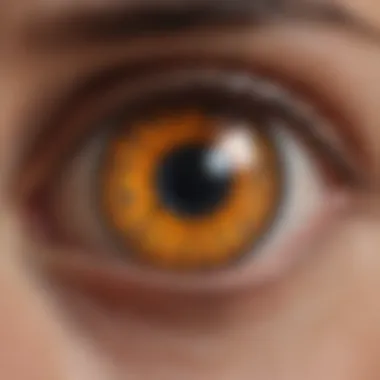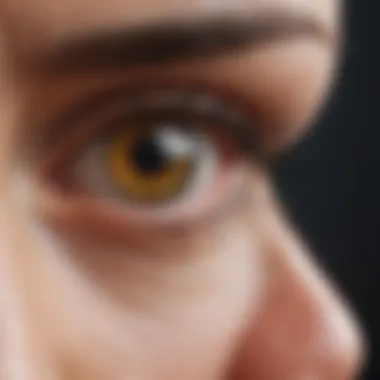Understanding Glaucoma Symptoms: A Comprehensive Overview


Intro
Glaucoma represents a range of eye conditions that can ultimately lead to irreversible vision loss. The intricate nature of this disease makes it essential for individuals to recognize its symptoms early on. This enables timely intervention and management, potentially preserving sight over the long term.
Understanding glaucoma necessitates familiarity with various terms and concepts associated with the condition. Such knowledge empowers both laypersons and professionals to respond appropriately when symptoms arise.
Key Concepts
Definition of Primary Terms
To build a strong foundation in understanding glaucoma symptoms, it is crucial to define some key terms:
- Intraocular Pressure (IOP): The fluid pressure within the eye, which, when elevated, can damage the optic nerve.
- Optic Nerve: The nerve that transmits visual information from the retina to the brain. Damage to this nerve can result in vision loss.
- Visual Field: This refers to the total area a person can see without moving their eyes. Loss of this field is a common symptom of glaucoma.
Related Concepts and Theories
Appreciating the context of glaucoma symptoms involves considering several other concepts:
- Primary vs. Secondary Glaucoma: Primary glaucoma occurs without underlying eye conditions, while secondary glaucoma develops due to other diseases or eye injuries.
- Angle Closure: A type of glaucoma where the drainage canals are blocked, causing a rapid increase in IOP.
- Chronic vs. Acute Symptoms: Chronic glaucoma often has subtle symptoms, while acute glaucoma may present severe signs that require immediate treatment.
"An understanding of intraocular pressure fluctuations and visual field changes is vital for early detection of glaucoma symptoms."
Future Directions
Gaps Identified in Current Research
Research continues to evolve, and several gaps remain in our understanding of glaucoma symptoms. Current studies may not fully capture the nuances of how different populations experience these symptoms. There is also a need for more longitudinal studies examining the long-term effects of early detection and intervention.
Suggestions for Further Studies
Future research could focus on the following areas:
- The impact of genetic factors on symptom presentation in glaucoma patients.
- How lifestyle choices and environmental factors contribute to the risk of developing glaucoma.
- Strategies to improve early diagnosis and management in at-risk populations.
Preamble to Glaucoma
Glaucoma represents a significant public health issue due to its potential to cause irreversible vision loss. Understanding this condition is crucial for both professionals in eye care and individuals interested in preserving their vision. This section will provide a foundational overview of glaucoma, defining the term and exploring its various types. By grasping the essential features of glaucoma, readers can better appreciate its symptoms, risk factors, and the urgency of early detection and treatment.
Definition of Glaucoma
Glaucoma encompasses a group of eye disorders primarily characterized by damage to the optic nerve, often linked to increased intraocular pressure. This pressure results from an imbalance in the production and drainage of aqueous humor, the fluid within the eye. Key to understanding glaucoma is the recognition that not all cases involve elevated eye pressure. Moreover, the damage to the optic nerve can lead to visual field loss, making early identification critical.
Types of Glaucoma
The classification of glaucoma is essential for tailoring treatment plans and interventions. There are several distinct types of glaucoma, each with unique characteristics and implications.
Open-Angle Glaucoma
Open-Angle Glaucoma is the most common form of the disease. It typically progresses slowly, often without noticeable symptoms in the early stages. The main characteristic of this type is the gradual loss of peripheral vision. The drainage angle in the eye remains open, but the trabecular meshwork becomes less efficient over time. This contributes to increased pressure.
Angle-Closure Glaucoma
In contrast, Angle-Closure Glaucoma occurs when the drainage angle is blocked. This can lead to a sudden increase in intraocular pressure, causing severe eye pain and headaches. It is often characterized by a rapid onset of symptoms, which can include blurred vision and seeing halos around lights. Recognizing this form of glaucoma is critical as it requires immediate medical attention to prevent permanent vision loss.
Normal-Tension Glaucoma
Normal-Tension Glaucoma is a unique entity where optic nerve damage occurs despite normal intraocular pressure levels. This form challenges the traditional understanding of pressure-related damage. It suggests that other factors, such as reduced blood flow to the optic nerve, might also play a role in vision loss. Identifying this glaucoma type can be complex, as it often presents similarly to Open-Angle Glaucoma without the associated high pressure.
Secondary Glaucoma
Finally, Secondary Glaucoma arises due to other conditions or factors, such as trauma, inflammation, or other eye diseases. Understanding this type is vital, as it may indicate an underlying health problem that requires further investigation. The symptoms can vary widely based on the primary condition, making it essential for healthcare providers to conduct thorough assessments.


"Glaucoma is a silent thief of sight. Early detection and intervention are crucial."
By discussing these types comprehensively, the article aims to equip readers with a clear understanding of glaucoma's complexity and the importance of monitoring eye health.
Symptoms Overview
In the realm of eye health, identifying the symptoms of glaucoma remains a critical focal point. This section dissects the various manifestations of glaucoma, underscoring their significance for early detection and intervention. Recognizing symptoms can make a considerable difference in treatment and management, as some patients may not notice changes until significant damage has occurred. Therefore, understanding these symptoms helps in maintaining eye health and potentially preserving vision.
Common Symptoms of Glaucoma
Loss of Peripheral Vision
Loss of peripheral vision is often a standout symptom of glaucoma. This type of vision loss can be gradual and may easily go unnoticed by individuals. It significantly contributes to the overall understanding of glaucoma, as it can indicate the progression of the disease.
A key characteristic of this symptom is the often limited awareness patients have regarding its development. The unique feature lies in the gradual nature of this vision loss, which may not become evident until it reaches advanced stages. This characteristic makes it a crucial focus for discussion in this article because timely recognition is essential for effective management and prevention of further deterioration.
Blurred Vision
Blurred vision can also serve as a symptom of glaucoma. This can affect clarity when viewing objects at any distance. While this symptom may arise from various other conditions, its presence in glaucoma underscores the importance of routine eye examinations.
Notably, blurred vision can manifest suddenly or progressively, complicating its assessment. This variability makes it an important subject in this article, as understanding this symptom is vital for early identification of glaucoma in patients. However, it may also be confused with other refractive errors, which can delay the recognition and subsequent management of the disease.
Halos Around Lights
Halos around lights represent another notable symptom. Individuals might observe rainbow-like reflections around light sources, particularly in low-light conditions. This symptom emerges primarily due to increased intraocular pressure, which distorts light as it enters the eye.
The distinct feature of halos is their connection to light perception at different times and settings, often leading to discomfort. This aspect is important for the article as it provides insight into visual disturbances that could signal glaucoma. Furthermore, this symptom could also be misattributed to other conditions, thus highlighting the need for professional evaluation.
Eye Pain
Eye pain can vary in intensity, ranging from mild discomfort to severe pain. This symptom often prompts individuals to seek medical attention. Particularly in cases of acute angle-closure glaucoma, eye pain can be pronounced and accompanied by nausea.
This symptom is significant due to its potential for rapid onset; understanding eye pain allows for immediate action and scrutiny. In this context, it serves as a valuable entry point for discussions about diagnosis and treatment paths in glaucoma management.
Symptoms by Glaucoma Type
Symptoms of Open-Angle Glaucoma
Open-angle glaucoma is the most prevalent form of the condition. It often presents with subtle symptoms, which can progress silently. Recognizing these symptoms is vital as the condition can lead to irreversible vision loss without noticeable signs until late in the disease.
The gradual nature of vision change sets it apart, making it important to educate both patients and clinicians. Stressing the importance of regular check-ups can drive home the significance of timely detection for better patient outcomes.
Symptoms of Angle-Closure Glaucoma
Angle-closure glaucoma may appear suddenly, making the symptoms more apparent. Individuals can experience severe eye pain, headache, and even nausea. The rapid progression of symptoms warrants immediate medical attention.
The acute nature of this response emphasizes its significance in this article, highlighting that quick recognition can mean the difference between temporary discomfort and lasting damage.
Symptoms of Normal-Tension Glaucoma
Normal-tension glaucoma, despite occurring at normal intraocular pressure levels, can lead to similar visual impairments experienced in other types. This condition is often overlooked due to the lack of elevated pressure readings, thus making the symptoms imperative to recognize.
The challenge associated with diagnosing normal-tension glaucoma is noteworthy. It becomes vital to convey that symptoms such as gradual visual loss still exist without pressure markers, proving the need for comprehensive evaluations in suspect patients.
Intraocular Pressure and Its Role
Intraocular pressure (IOP) is a critical factor in the understanding and management of glaucoma. This section examines its importance within the context of glaucoma symptoms and progression. Maintaining appropriate IOP levels is crucial for protecting the optic nerve from damage. Elevated IOP is the most recognizable risk factor for developing glaucoma, yet it is essential to consider that not everyone with high IOP will experience vision loss. Thus, understanding IOP requires a comprehensive approach.
Monitoring IOP can guide both diagnosis and treatment strategies. Physicians often rely on IOP readings to determine the severity of a patient's condition. Regular measurements can help initiate early intervention, potentially slowing the disease's progression. This is particularly important because glaucoma can manifest symptoms that are not immediately evident to the patient.
Understanding Intraocular Pressure


Intraocular pressure is generated by the balance between the production and drainage of aqueous humor, the fluid inside the eye. It is a dynamic process affected by various factors, including:
- Aqueous humor production: The ciliary body produces this fluid, maintaining eye shape and nutrient supply.
- Drainage pathways: The trabecular meshwork and uveoscleral pathways are responsible for draining aqueous humor out of the eye.
- Ocular health: Any obstruction or dysfunction in these pathways can affect IOP.
In healthy eyes, normal IOP typically ranges from 10 to 21 mmHg. When IOP rises above this range consistently, there is a greater risk for damage to the optic nerve, leading to glaucomatous changes. Therefore, understanding how IOP functions is essential for grasping the underlying mechanisms of glaucoma.
Pressure Fluctuations and Symptoms
Fluctuations in IOP can occur in response to daily activities, sleep cycles, and medical conditions. These fluctuations can impact an individual's vision in various ways:
- Silent Symptoms: Pressure increase may not manifest as immediate pain but can gradually affect peripheral vision.
- Acute Symptoms: In angle-closure glaucoma, rapid spikes in IOP can cause severe headaches, nausea, and visual disturbances.
- Long-term Deterioration: Continuous high IOP may lead to irreversible vision loss if not addressed promptly.
Recognizing the relationship between pressure changes and symptoms can support improved patient outcomes. Individuals with glaucoma should be vigilant about their eye health, particularly if they experience any sudden changes in vision. Regular eye exams are vital for monitoring IOP and identifying any necessary interventions.
"Regular monitoring of intraocular pressure is integral to glaucoma management. It provides an essential tool for early detection and intervention, reducing the risk of vision loss."
Visual Field Changes
Visual field changes are a crucial aspect when discussing glaucoma symptoms. Understanding these changes can help in the early detection of this condition. Glaucoma often leads to specific visual field loss patterns, which can be indicative of the severity and progression of the disease. Recognizing these patterns is essential for both patients and eye care professionals.
What is Visual Field Loss?
Visual field loss refers to a decrease in the ability to see in certain parts of the visual field. This loss can be partial or total, and it may occur in varying degrees. For individuals with glaucoma, this type of loss often presents as a gradual decline in peripheral vision, but it can affect central vision as well. As the condition progresses, these changes might be subtle at first, making it challenging to identify without regular eye examinations.
Patterns of Visual Field Loss in Glaucoma
Visual field loss in glaucoma commonly follows distinct patterns, including:
Central Vision Loss
Central vision loss occurs when the area in the middle of the visual field deteriorates. This loss can significantly affect tasks that require detailed vision, such as reading or recognizing faces. It is important to note that this type of vision loss can be very distressing for individuals. The key characteristic is that patients may retain peripheral vision for some time, delaying the realization of a problem. Awareness of central vision loss is critical for prompt diagnosis and management of glaucoma, making it a popular choice for discussion in this article.
Advantages of recognizing central vision loss include the ability to monitor changes that may warrant further testing or intervention. However, one disadvantage is that central vision loss can lead to a false sense of security, as individuals may not perceive the urgency of seeking help until significant damage has occurred.
Peripheral Vision Loss
Peripheral vision loss is the more common type of visual field loss associated with glaucoma. In this scenario, the outer edges of the visual field diminish, leading to a tunnel-like effect. This reduction can progress gradually, often unnoticed until significant damage has occurred. The key characteristic of peripheral vision loss is that it can compromise the ability to see objects or movements from the sides, which is vital for daily activities like driving.
This type of loss is beneficial to discuss in relation to glaucoma because it directly relates to the disease mechanism itself. A unique feature is that patients often do not realize they are losing peripheral vision until they experience severe restrictions. On the downside, the late recognition of peripheral vision loss may lead to advanced disease stages by the time it is noticed.
Tunnel Vision
Tunnel vision is a severe type of visual field loss where only a small central portion of vision remains. This condition often progresses to a point where individuals can see only straight ahead, resembling looking through a tube. This pattern of vision loss can dramatically affect mobility and overall quality of life.
The primary characteristic of tunnel vision is the detrimental impact it holds on spatial awareness, causing a heightened risk of accidents. Recognizing this loss is vital in glaucoma management. A unique feature of tunnel vision is that it can serve as a clear red flag for both patients and healthcare providers, indicating advanced glaucoma. However, the disadvantage might be that it often represents a late stage of the condition, at which point irreversible damage has already occurred.
"Early detection of glaucoma is critical to prevent irreversible vision loss. Understanding visual field changes is an essential aspect of this detection."
In summary, the patterns of visual field loss in glaucoma contribute significantly to the understanding of the disease's progression and the urgency of early intervention. Recognizing these changes can assist in preserving vision and enhancing treatment outcomes.
Early Detection and Importance
Detecting glaucoma early is crucial for preserving vision and preventing further deterioration of eye health. Glaucoma is often referred to as the "silent thief of sight" because it can progress without noticeable symptoms in its early stages. This makes awareness of its significance essential for timely intervention.
In this context, early detection encompasses regular monitoring and understanding symptoms that may arise. Both of these elements contribute to effective management and treatment strategies. The earlier glaucoma is detected, the better the chances are to prevent permanent vision loss. With an increase in the aging population, glaucoma's prevalence has risen, so a proactive approach is vital.
Regular screenings can lead to the identification of glaucoma even before symptoms appear. Educating patients and encouraging routine eye examinations must be prioritized. Many individuals may not realize that they are at risk until significant damage has occurred, underscoring the necessity of awareness.
The Role of Regular Eye Exams
Regular eye exams play a key role in the early detection of glaucoma. Eye care professionals can measure intraocular pressure, examine the optic nerve, and perform various tests to monitor visual fields. These comprehensive assessments provide valuable insights into a person's ocular health.


Persistent monitoring through these exams can catch changes in eye function that may indicate the onset of glaucoma. Although glaucoma can affect anyone, certain groups are at higher risk, such as those with a family history of the disease or individuals over the age of 60. Regular eye exams become even more critical for these populations.
The American Academy of Ophthalmology recommends initial screenings at age 40 for individuals at risk, while younger individuals should have exams based on their personal or family medical histories. By adhering to these guidelines, individuals can safeguard their vision effectively.
Recognizing Symptoms Early
Timely recognition of glaucoma symptoms is another essential factor in preventing vision loss. As previously mentioned, symptoms may not be apparent until the disease has significantly progressed. However, awareness of common indicators can prompt individuals to seek medical advice sooner.
- Loss of Peripheral Vision: This is often one of the first signs that may go unnoticed.
- Blurred Vision: Changes in clarity can signify worsening conditions.
- Halos Around Lights: Some patients report experiencing halos, especially during night-time.
- Eye Pain: Sudden eye pain may occur, particularly in angle-closure glaucoma.
Encouraging awareness around these signs can lead to a faster response and a better chance of preserving sight. Individuals should actively monitor their visual changes and consult an eye care provider if any symptoms arise. With early detection and appropriate management, the impact of glaucoma can be minimized.
Diagnosis of Glaucoma
The diagnosis of glaucoma holds significant weight in the context of eye health. Accurate diagnosis is crucial for preventing irreversible vision loss associated with this condition. Early detection allows for timely intervention, which can preserve visual function and improve the quality of life for affected individuals. Several key factors underscore the importance of utilizing various diagnostic methods to ensure comprehensive assessment and management of glaucoma.
Timely diagnosis can also identify other potential ocular conditions that may coexist with glaucoma. This holistic approach helps in creating tailored treatment plans that suit the individual's specific needs. With the right tests, eye care professionals can assess intraocular pressure, evaluate visual field loss, and monitor the optic nerve's health.
Diagnostic Tests for Glaucoma
In identifying glaucoma, several diagnostic tests are indispensable. Each test brings its unique capabilities to the evaluation process, contributing significantly to achieving a precise diagnosis and understanding of the condition.
Tonometer Measurements
Tonometer measurements are a fundamental aspect of diagnosing glaucoma. This test directly measures intraocular pressure (IOP), which is a pivotal factor in glaucoma development. High pressure can indicate a risk factor for glaucoma. The key characteristic of tonometry is its ability to provide immediate feedback about IOP levels, which makes it a beneficial choice for eye health assessment.
A unique feature of tonometer measurements is their non-invasive nature. Most types, such as the Goldmann applanation tonometer, are quick and simple for the clinician and comfortable for the patient. However, a disadvantage could be false readings due to corneal thickness or other variables that can sometimes affect IOP subtly but significantly.
Visual Field Testing
Visual field testing evaluates the range of vision and detects any peripheral vision loss that may point towards glaucoma. This test is essential because glaucomatous damage often starts in the peripheral regions. The key characteristic of visual field testing is its ability to track changes over time, making it a powerful tool for monitoring disease progression. This is particularly useful for deciding the effectiveness of treatments.
The unique feature of visual field testing is that it provides detailed information about the specific functional areas of the retina. However, the disadvantage includes that the testing process can sometimes be uncomfortable for patients and may require multiple visits for comprehensive analysis.
Optic Nerve Imaging
Optic nerve imaging is a critical element in the glaucoma diagnostic process. This technology allows for the visual assessment of the optic nerve's structure. It is vital that the optic nerve is healthy because damage can indicate advanced glaucoma. The key characteristic of this imaging is its high-resolution capability, which provides detailed structural information that can inform a diagnosis.
One unique aspect of optic nerve imaging is its ability to capture changes over time, enabling a longitudinal view of the patient’s optic health. While it is an indispensable tool, its disadvantages include the cost associated with advanced imaging technologies and the potential need for specialized skills to interpret the results.
Symptoms and Testing Correlation
Understanding the correlation between symptoms and diagnostic testing is paramount in the assessment of glaucoma. Symptoms such as loss of peripheral vision or difficulty seeing in low light are often integral to the diagnostic process. Each test contributes a layer of information that can either confirm or clarify the symptoms presented.
For instance, elevated intraocular pressure recorded in tonometry links directly to symptoms of eye strain, but may not always correlate with visual field loss. Visual field tests might detect changes that a patient does not perceive, underscoring the importance of comprehensive evaluation.
"Each diagnostic test offers a different perspective but come together to form a complete picture of the patient’s ocular health."
Overall, this approach not only enhances the accuracy of diagnosis but also ensures that the management strategies implemented are based on a thorough understanding of both symptoms and test results.
Finale
Understanding the symptoms of glaucoma is essential in mitigating the risks associated with this complex condition. Glaucoma often develops silently, leading to irreversible vision loss if not detected early. Regular monitoring for symptoms such as loss of peripheral vision, blurred vision, and the presence of halos can be pivotal in ensuring timely intervention.
Summary of Key Symptoms
Key symptoms to be aware of include:
- Loss of Peripheral Vision: One of the earliest signs of glaucoma, often unnoticed until significant damage occurs.
- Blurred Vision: Can indicate fluctuations in pressure, which may worsen over time.
- Halos Around Lights: Generally a symptom associated with angle-closure glaucoma, indicating increased pressure.
- Eye Pain: This may signal an acute attack and needs immediate medical attention.
These symptoms are critical indicators that necessitate further examination. Their identification can lead to early diagnosis and treatment, influencing the progression of the disease.
Future Considerations in Glaucoma Management
As research continues, several considerations emerge for future glaucoma management:
- Advancements in Diagnostic Techniques: Emerging technologies in imaging and testing could enhance the accuracy of glaucoma detection.
- Personalized Treatment Plans: Tailoring treatment to individual patient profiles may improve outcomes and adherence.
- Public Awareness Campaigns: Educating the community about symptoms and the importance of regular eye exams could facilitate earlier intervention.
Thoughtful management of glaucoma hinges on understanding its symptoms clearly. With ongoing advancements and a focus on preventative measures, there is hope for improved trajectories in patient care and vision preservation.



